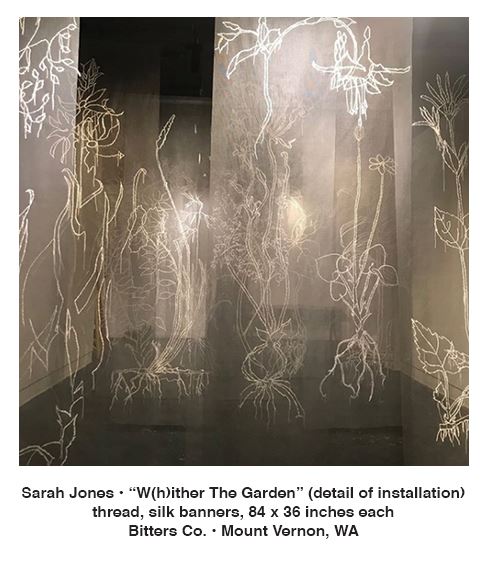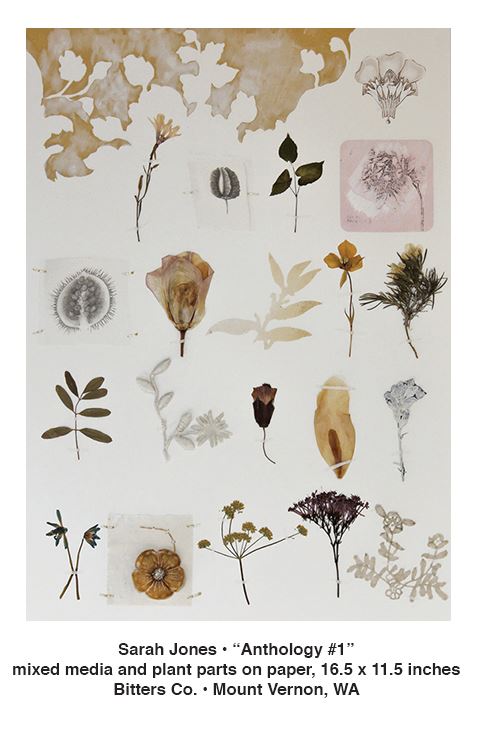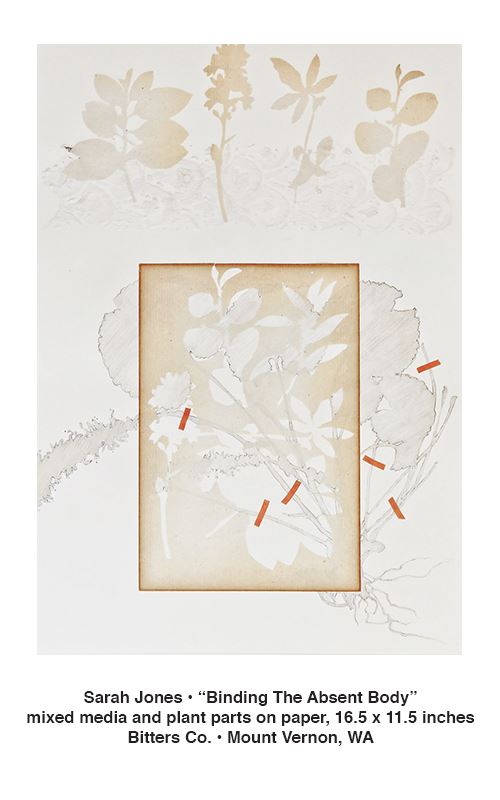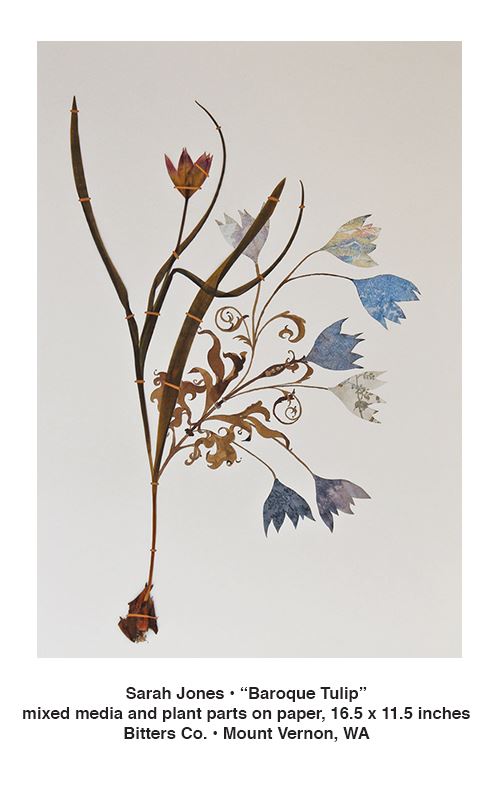 As art venues open and restrictions are lifted, there are many exciting art events in the area visit. If you live in Western Washington and want to take a road trip in the beautiful Pacific Northwest summer, please consider making Skagit County that destination. There are several art events that deserve your time and attention. One such art experience is a quick drive across the river from downtown Mount Vernon. Here you find the Bitters Co. barn where Sarah Jones’ installation, “W(h)ither The Garden” is being exhibited. The title of the show is inspired by an essay about gardening during times of war by English author Vita Sakville-West and is meant to evoke both sense of loss and hope during times of deterioration. A historic barn in the pastoral Skagit Valley creates the perfect setting for Jones’ installation.
As art venues open and restrictions are lifted, there are many exciting art events in the area visit. If you live in Western Washington and want to take a road trip in the beautiful Pacific Northwest summer, please consider making Skagit County that destination. There are several art events that deserve your time and attention. One such art experience is a quick drive across the river from downtown Mount Vernon. Here you find the Bitters Co. barn where Sarah Jones’ installation, “W(h)ither The Garden” is being exhibited. The title of the show is inspired by an essay about gardening during times of war by English author Vita Sakville-West and is meant to evoke both sense of loss and hope during times of deterioration. A historic barn in the pastoral Skagit Valley creates the perfect setting for Jones’ installation.
 Bitters Co. is a design and product development company based in Skagit Valley. Amy and Katie Carson are sisters who founded the company to share their appreciation of craft from around the world. In their words, “Located in rural Skagit Valley the spacious, unobstructed hay loft of our 1900’s barn is a welcoming space for art in its many forms; installation, two dimensional, culinary, musical, performance, and literary. We call it a flex space for promotion of the arts.” And from July 17-August 14, “W(h)ither The Garden,” an installation by artist Sarah Jones, is on display in the loft. The installation includes two key components: mixed media and plant parts on paper and silk banners that stretch from ceiling to floor. Both aspects of the installation feature three main themes of the artist’s body of work: botanicals, the documentation of loss that is often seen or referenced through memento mori imagery, and the invisible. These ideas come together to create a powerful statement about climate change and how people can emotionally move through the loss.
Bitters Co. is a design and product development company based in Skagit Valley. Amy and Katie Carson are sisters who founded the company to share their appreciation of craft from around the world. In their words, “Located in rural Skagit Valley the spacious, unobstructed hay loft of our 1900’s barn is a welcoming space for art in its many forms; installation, two dimensional, culinary, musical, performance, and literary. We call it a flex space for promotion of the arts.” And from July 17-August 14, “W(h)ither The Garden,” an installation by artist Sarah Jones, is on display in the loft. The installation includes two key components: mixed media and plant parts on paper and silk banners that stretch from ceiling to floor. Both aspects of the installation feature three main themes of the artist’s body of work: botanicals, the documentation of loss that is often seen or referenced through memento mori imagery, and the invisible. These ideas come together to create a powerful statement about climate change and how people can emotionally move through the loss.
 The works on paper are reminiscent of early botanical drawings. An attempt to document newly discovered plants and animals, these drawings blended scientific observation with artistic expression. However, Jones’ works take on a different meaning. A mix of dried and pressed plant specimens, cut-outs of plants in paper, drawings, and pieces of tape used to adhere the materials, these works take on a more documentational quality than some early botanical images. In a conversation with the artist, Jones described these as archival and a way for her to detail loss. There is beauty in this work; the materials are dissected and then rearranged in various scenes and compositions. But there is also something uncomfortable or unsettling about how these once living things were plucked from the land. The viewer is reminded that these beautiful objects are now dead. Once living and flourishing, they are now used to archive a species or type of plant. Maybe this is a way for Jones to help the viewer mourn the loss that is already occurring.
The works on paper are reminiscent of early botanical drawings. An attempt to document newly discovered plants and animals, these drawings blended scientific observation with artistic expression. However, Jones’ works take on a different meaning. A mix of dried and pressed plant specimens, cut-outs of plants in paper, drawings, and pieces of tape used to adhere the materials, these works take on a more documentational quality than some early botanical images. In a conversation with the artist, Jones described these as archival and a way for her to detail loss. There is beauty in this work; the materials are dissected and then rearranged in various scenes and compositions. But there is also something uncomfortable or unsettling about how these once living things were plucked from the land. The viewer is reminded that these beautiful objects are now dead. Once living and flourishing, they are now used to archive a species or type of plant. Maybe this is a way for Jones to help the viewer mourn the loss that is already occurring.

The suspended banners are made of white silk with white botanical appliqués and pair nicely with the works on paper. This combination results in a show that is quite experiential and immersive. Imagine walking up the stairs to a loft in a barn: your vision is the first to enter the space, which is filled with white, flowing banners. The interior space becomes a white meadow moving with the wind blowing in from the outside. The scene is intended to be comforting and familiar, like curtains on a windy summer day. However, there is still an undercurrent of loss in the work. The banners are suspended to occupy a liminal space in the loft. Not quite grounded, they aren’t on the same plane as the viewer. At the same time, the scene is both sad and comforting as if Jones is assisting the viewer through the process of grief.
 According to Jones, we can create meaning out of loss. In her statement for the show, she writes about the importance of the Skagit Valley and how the act of traveling to such a serene and nostalgic place helps guide the viewer through this experience. The pastoral, the nostalgic, the closeness of the water, all these factors create an atmosphere for the viewer to encounter this challenging message. The relics created by Jones are a contemporary memento mori, a soothing reminder that the meadow is withering. Wither to the garden to experience both its beauty and its loss. This play on words poetically summarizes the artist’s thesis and bids the viewers to enter the meadow.
According to Jones, we can create meaning out of loss. In her statement for the show, she writes about the importance of the Skagit Valley and how the act of traveling to such a serene and nostalgic place helps guide the viewer through this experience. The pastoral, the nostalgic, the closeness of the water, all these factors create an atmosphere for the viewer to encounter this challenging message. The relics created by Jones are a contemporary memento mori, a soothing reminder that the meadow is withering. Wither to the garden to experience both its beauty and its loss. This play on words poetically summarizes the artist’s thesis and bids the viewers to enter the meadow.
Chloé Dye Sherpe
Chloé Dye Sherpe is a curator and art professional based in Washington State.
“W(h)ither The Garden” opens Saturday, July 17, from 12-3 P.M. at Bitters Co. Barn located at 14034 Calhoun Road in Mount Vernon, Washington. The exhibit is on view Thursday through Monday from 12-4 P.M. For more information call (360) 466-3550 or email studio@bittersco.com.